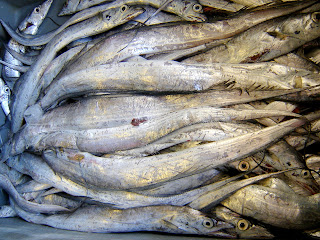So, this guy.
In Texas it's usually called a Ribbonfish, though one does hear Cutlassfish pretty often, and a few folks use the handle Scabbardfish. Sometimes it's Sabrefish. It has the head of a dragon and a long skinny body that tapers to an insignificant tail.
Inshore Shrimpers will haul in hundreds of pounds of them, from a few inches to more than a foot. They are tossed overboard, sometimes sold for bait. Bait shrimpers do of course keep them, and get up to a dollar a dozen (for the large ones) during the peak of recreational fishing season. Little ones are found close inshore while bigger fish may be found anywhere from bays to waters a hundred miles offshore.They possess no scales, but have metallic skin so bright when they first come out of the water that one might be forgiven for thinking one had hooked a piece of aluminum foil rather than a fish. Except that foil generally doesn't have teeth the boogeyman might have wished for while blowing out his birthday candles. The teeth are- at least to a human- ornamental, having no real jaw power with which to back up the admittedly nasty bite. Those weekend fishermen who do catch one are inevitably disappointed, as the bite is followed by no fight at all, and the reward is a skinny fish which, while pretty, looks as edible as that piece of aluminum foil. Ribbonfish grow to be several feet long, though even at that length they only weigh a few pounds. They are everywhere, and cursed by most fishermen on the coast. Most, but not all. More on that in a bit.
Search for "Ribbonfish" and a few interesting things pop up. But not much.
Search using the scientific name: Trichiurus lepturus. Now it's interesting. Turns out this fish has a generally accepted common name as well- the Largehead Hairtail. Not only is this fish found elsewhere, but it is fished elsewhere...in vast numbers. Turns out the Pacific Hairtail comprises the 6th largest wild marine fishery by weight in the world. The primary fishing and market nations are China and South Korea, though the fishery extends throughout the Pacific and Indian Oceans. Go to the seafood counter at Super Hmart. Hairtail is almost always available, both regular (which is cheap) and Ike Jime (which isn't so cheap). In our neighborhood, Hong Kong usually has the fish fresh, and always has it frozen in various market forms. I do not recommend sourcing your Ribbonfish from these establishments necessarily- I merely point them out for illustrative purposes.
Which brings us back to local fisheries. I said most recreational fishermen don't like them. If, however, you go to the right place at night (one place is on Galveston, though I will not divulge where), you will find dozens of men, all of Vietnamese extraction, patiently fishing and catching gigantic Ribbonfish. They use cane poles with a tiny weight and a long sliver of ribbonfish as bait. The line is tossed in, the fisher gently bobs the bait, then hauls in the three- to four-foot fish. A few masters of the art, like a diminutive gentleman appropriately named "Shorty", don't just tie a rod's length of line on, but use spools they wind around their hands. I have been told that Shorty can cast a rig weighing a couple of ounces almost 75 feet. Using a cane pole.
So, what does one do with the Ribbonfish once it has been caught or bought? If the fish is large, gut it and cut the fish into steaks 2 inches long. No scaling is possible, as no scales are visible. Instead, the silver sheen comes off on the hands. A couple of hours messing with ribbonfish leaves my hands looking like they belong to Ziggy Stardust's makeup guy. But back to the fish- the steaks can be grilled or stir fried. The meat is white, though fatty, so brisk cooking is in order. They may however be pan-braised with strong flavors (pork, mushrooms, tomatoes).
That same size Ribbonfish, again cut into steaks, makes an interesting subsitute for sardines. They may be prepared in the same ways, with the added bonus that the bones will be larger, and thus easier to work around. We have some Ribbonfish escabeche lurking somewhere in the fridge as I write this, and I imagine it is now hovering at the farthest end of the ripeness spectrum. Ribbonfish are generally not suited for soups unless you plan on cooking them to disintegration.
Little Ribbonfish are a different kettle of fish. The bones are the same, only smaller. The meat is good, but the effort required to get at it and it alone is not worth it for most people. For fish around a foot or so long, the bones don't usually get brittle enough during frying to be eaten whole. Which leads to thoughts of drying.
Drying is possibly the most magical thing ever to happen to seafood. It's Technicolor. Drying is perfect for ribbonfish. Cutting heads off ensures the best drying in home equipment, but those with access to commercial dryers should go for head-on. Gut the fish, brine for a few minutes, dry to shelf-stable dessication. Store in the pantry, in a paper bag. Shelf life is a couple of years.
Fry the dried Ribbonfish in a wok, drain, then serve as is, with rice and sauce of some sort. Or cook them with vegetables like pea shoots or softer greens. In which case think of the dried Ribbonfish (which may be chopped or broken into chunks) as analogous to the role bacon might play in a similar dish. Just a bit for flavor. They're good for snacks on the go and for a kid's lunch.
There is no dependable source of local, high-quality Ribbonfish and Ribbonfish products. But we're working on changing that soon.


